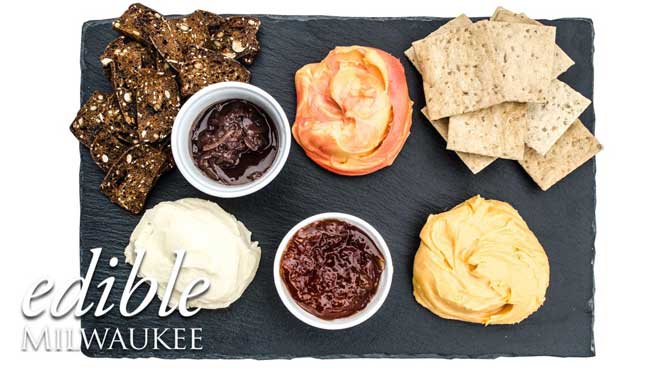Go (Cold) Pack Go: Exploring Cold Pack Cheese Spread
You may or may not remember the first time you tried cold pack cheese spread. I do. I remember it like one remembers a first kiss, first joint, or first shot of liquor: totally foreign, slightly confusing, and worth another taste. What was this stuff, I wondered as I gazed down into the little plastic tub, one of my grandma’s stubby cocktail spreaders plunged into its surface like a flag on the moon.
It tasted like cheese. It looked like cheese. But its tangy, spreadable goodness had been foreign to me until this moment. As the Christmas lights twinkled and time stood still, I ate at least a sleeve’s worth of Town House crackers smeared with sharp cheddar cold pack and fell in love with the stuff.
But what was it, exactly?
Sometimes referred to as “club cheese” or “crock cheese,” cold pack is a spread made from different batches of the same variety of cheeses, or from two or more varieties of mild and sharp natural cheese that have been ground to a paste and mixed with cream and other dairy ingredients. Herbs, spices, nuts, beer, wine, vegetables or other flavors are added, resulting in numerous combinations.
Its name signifies that it’s made without the aid of heat. Unlike processed cheese, cold pack isn’t heat-treated or cooked before packaging, and as a result tastes much more like a spreadable version of siblings like cheddar or Swiss. But what’s more interesting than how it’s made is where it was made in the first place, and why.
Like many good ideas before it, cold pack was literally born on a Wisconsin bar top. It’s said that tavern owners in the early 1900s, including at Milwaukee’s Pabst Brewery, mixed bits of different cheeses as a snack for customers. In a nod to these origins, some still refer to cold pack as “pub cheese.”
A similar origin story from the Center for Dairy Research (CDR) at the University of Wisconsin-Madison posits that cold pack began its life as a sort of dip or spread made from old cheeses that were beginning to dry out, possibly influenced by Pot Käs, a potted cheese native to Sweden that’s similar to cold pack.
According to the CDR, a beer depot operator named Hubert Fassbender began giving homemade cold pack cheese to his best customers in 1933. Customers started asking for the cheese without the beer and Fassbender’s Kaukauna Klub cheese business grew from there, making him the first manufacturer of cold pack. In 1934, Armin Herke started using surplus cuts of cheese to produce cold pack and formed the Calumet Cheese Co., which later became known as WisPride and is now owned by Chicago’s Bel Brands.
“Cold pack is really one of those iconic foods that come from Wisconsin,” said Heather Porter Engwall, director of national product communications for the Wisconsin Milk Marketing Board. “Along with things like brats, cheese curds, beer and sausage, cold pack is very much associated with the state, and the wide variety available makes it a popular item.”
Variety is the Spice
While there are countless varieties sold and consumed across our fair state, there are a few standard-bearers whose products are a creamy swirl above the rest.
In 1964, Philip Lindemann formed Pine River Pre-Pack, which was manufacturing 17 flavors of cold pack cheese by 1979. Today, Pine River is located in Newton, south of Manitowoc along Lake Michigan, where it continues to manufacture not only cold pack, but private-label cheese for other cheese companies, such as Widmer’s Cheese Cellars, whose brick cheese and brick cheese spread are especially well-regarded.
Kraemer Wisconsin Cheese of Watertown specializes in cheese spreads going back dozens of years. Owner Jim Kraemer and family make 13 varieties in small, 40-pound batches, adding up to more than 500,000 pounds of product each year. Its unique flavors include Cheddar Apricot Honey and Cheddar Port Wine, which combines sharp cheddar with Crimson Royale Wine from Von Stiehl Winery in Algoma.
Brunkow Cheese in Darlington makes eight varieties of cold pack, including a cranberry variety that uses raw milk cheddar and Wisconsin cranberries. Chalet Cheese makes a limburger spread that’s as sweet as its block sibling but without much of the scent, because there is no rind. Old Fashioned Cheese of Mayville makes nine varieties. Other Wisconsin cold pack producers include Old Tavern Food Products, Jim’s Cheese, North Country Cheese, Renard’s Cheese, Saputo Specialty Cheese, Shullsburg Creamery, Vern’s Cheese, Weyauwega Cheese, Wisconsin Cheeseman, and many more.
Bel Brands USA, a Chicago-based subsidiary of international cheese company Fromageries Bel in Paris known primarily for its ubiquitous Laughing Cow brand Mini Babybel wheels, produces multiple brands of cold pack cheese at its facility in Little Chute, Wis. These include familiar and widely available favorites like Merkts, Owl’s Nest, WisPride and Kaukauna, the original manufacturer founded by Hubert Fassbender.
Figi’s Gifts in Good Taste, which is based in Marshfield and specializes in packaged gift boxes featuring cheese, meats, nuts, chocolate and more, sells several varieties of cheese spread in the forms of flavored spreads, molded logs rolled in nuts, and ceramic crocks. Among its more unusual offerings is a two-pound creation called the Honey ‘n Pecan Cheese Torte, which includes cheddar and Swiss layered with pecans and honey. It’s touted as award-winning and is rated highly on the company’s website.
More Than Just a Cheap Snack
Like other handcrafted Wisconsin food products with some history, cold pack cheese is gaining broad respect as a medium for serious expressions of flavor and craft. It’s a versatile ingredient suited for more than just a topping on a cracker; it can be used in sandwiches, soups, pasta, potatoes, cheese sauces and more.
“You can create and use cold pack cheese in so many ways,” said Engwall. “While most people buy them to spread on crackers or to make a cheese ball, it’s also a versatile ingredient. It’s portable, reusable and fun to play around with.”
Not content with being thought of as just a simple snack food, cold pack spread is gunning for trophies, too.
Family Fresh Pack, of Belleville, has won awards for its cheeses at the World Championship Cheese Competition, the American Cheese Society, US Championship Cheese Competition, and Wisconsin State Cheese and Butter Competition. Sugar Brook Farms in Verona has been awarded at the World Cheese Championships for its peppadew cheddar and blue cheese & cheddar spreads, and Scott’s of Wisconsin in Sun Prairie has also won awards for its cold pack.
Kraemer Cheese’s cheddar beer cold pack, made with Eastside Dark lager from Milwaukee’s Lakefront Brewery, won a gold medal at the 2010 World Cheese Championships. It was the company’s first ever entry in a cheese contest. Kraemer has also taken to introducing a new flavor of cold pack at the World Dairy Expo each year, having debuted smoked gouda, pumpkin beer, and mango salsa spreads in recent years.
Increasing Demand, Possibilities
According to the Center for Dairy Research, 59 Wisconsin plants produced 48 million pounds of cold pack cheese in 1978. Data from USDA’s National Agriculture Statistics Service show moderate growth since then. After several years of double digit percentage decline between the early 1990s and the early 2000s, production grew again by double digits annually between 2001-2004, when the state produced nearly 64 million pounds. Since 2002, all cold pack cheese produced in the U.S. has come from Wisconsin.
It’s reasonable to assume that this affection for cold pack cheese, especially as a key component of any respectable Dairy State holiday spread, has helped boost sales and awareness over time. Patty Peterson of Larry’s Market, a specialty food shop in Brown Deer, said cold pack sales always ramp up near the holidays.
“We don’t normally go too crazy with cold pack, except at the holidays when we expand our line,” she said. “We always carry Pine River Sharp Cheddar, and getting closer to the holidays we get their Port Wine flavor, which is a big seller. This year, we’ll have their chocolate cheese spread, which is very impressive.”
Peterson said the best seller at Larry’s during the holidays is Widmer’s Brick spread. “It’s like crack cheese,” she said with a laugh.
“Potter’s Crackers [an artisan brand made in Madison] go really well with cold pack, especially a simple cheddar spread with some of their flavored varieties. It works because it’s not like you’re masking a really good piece of cheese with an overpowering cracker.”
She added that she has also served cold pack with a pepper jelly over the top of it, or used quality preserves like the Shallot Confit with Red Wine made by Quince & Apple, another artisan producer in Madison.
Annette DuBois, owner of Bieri’s Jackson Cheese and Deli in Jackson, said that her shop carries Laack Bros. Cheese Co. cold pack exclusively, stocking 13 varieties. She occasionally carries Pine River spreads as well.
“We’ve always done really well with cold pack on a regular basis, but we sell many times more during the holidays,” she said. “We go through maybe 20 cases a week, where we normally sell maybe three cases a week the rest of the year.”
Though its value as a holiday table component can’t be ignored, the versatility and flavor of cold pack cheese spread make it a year-round staple worthy of a second (and third, and fourth) look. As I think back to my own exuberant exploration of the cold pack flavors that made regular appearances in our family’s fridge—swiss almond, port wine, sharp cheddar, and more—I’m left with fond memories and a serious appetite. As a matter of fact, I’m headed out to buy some right now.






